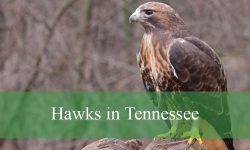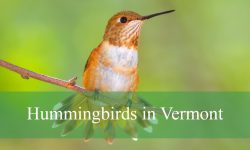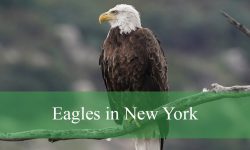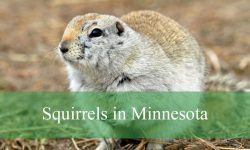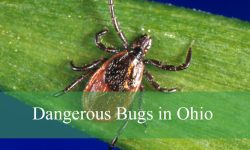Massachusetts hosts a rich variety of bird species, from vibrant songbirds to majestic waterfowl. Its diverse habitats, including forests, wetlands, coastal areas, and urban parks, support both year-round residents and migratory visitors.
Iconic birds like the Northern Cardinal, American Robin, and Great Blue Heron can be spotted throughout the state. Each species has distinct features, behaviors, and calls that make identification engaging and educational.
Exploring local trails, backyards, or coastal marshes becomes more rewarding with knowledge of common birds. This guide highlights 47 frequently seen birds in Massachusetts, complete with pictures and identification tips.
Common Birds Found in Massachusetts
Black-capped Chickadee
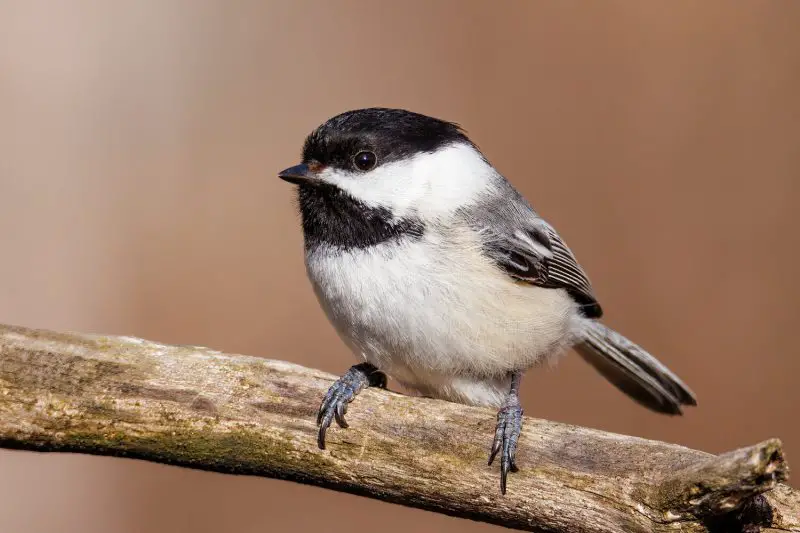
The Black-capped Chickadee is the official state bird of Massachusetts and a favorite among birdwatchers for its curious nature and distinctive appearance. It has a black cap and bib, white cheeks, and soft gray wings and back. Its small, round body and short bill give it a charming look that is easily recognizable in backyards and forests alike.
Measuring just 4.7–5.9 inches in length with a wingspan of 6–8 inches, this tiny bird is full of personality. Its familiar “chick-a-dee-dee-dee” call serves both as a social signal and as a warning of predators, with the number of “dee” notes increasing depending on the level of threat. Chickadees are known for their boldness, often approaching humans more closely than other species.
The Black-capped Chickadee feeds on seeds, berries, and insects, frequently visiting bird feeders throughout Massachusetts, especially in the winter months. They inhabit deciduous and mixed forests, parks, and suburban areas. Adaptable and hardy, they remain year-round residents, surviving harsh winters by caching food and fluffing their feathers for insulation.
Northern Cardinal
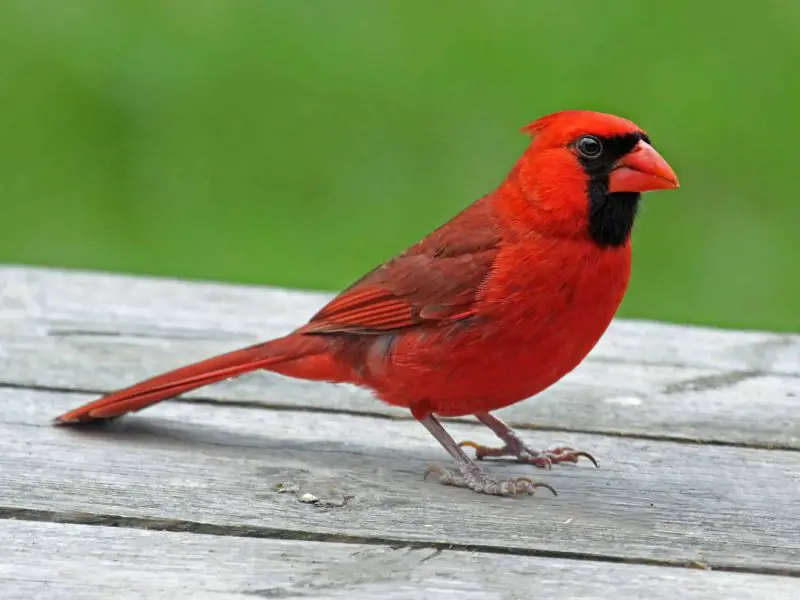
The Northern Cardinal is one of the most easily recognized birds in Massachusetts, thanks to its brilliant red plumage in males and warm brown tones with red highlights in females. Both sexes share a prominent crest on the head and a thick, cone-shaped orange bill that is perfectly adapted for seed eating. Their striking appearance makes them stand out in both urban and rural settings, especially against the snow in winter.
In terms of size, Northern Cardinals measure about 8–9 inches in length with a wingspan of 10–12 inches. They are medium-sized songbirds with a sturdy body, long tail, and strong legs. Males sing loud, melodic whistles from exposed perches, especially during the breeding season, to defend territory and attract mates. Their songs and calls are commonly heard in Massachusetts backyards throughout the year.
Northern Cardinals are primarily seed eaters, favoring sunflower seeds, grains, and fruits, though they also consume insects during the breeding season. They are non-migratory and thrive in Massachusetts’ woodlands, parks, and suburban gardens. Their year-round presence, striking coloration, and cheerful songs make them one of the most beloved backyard birds in the region.
Blue Jay
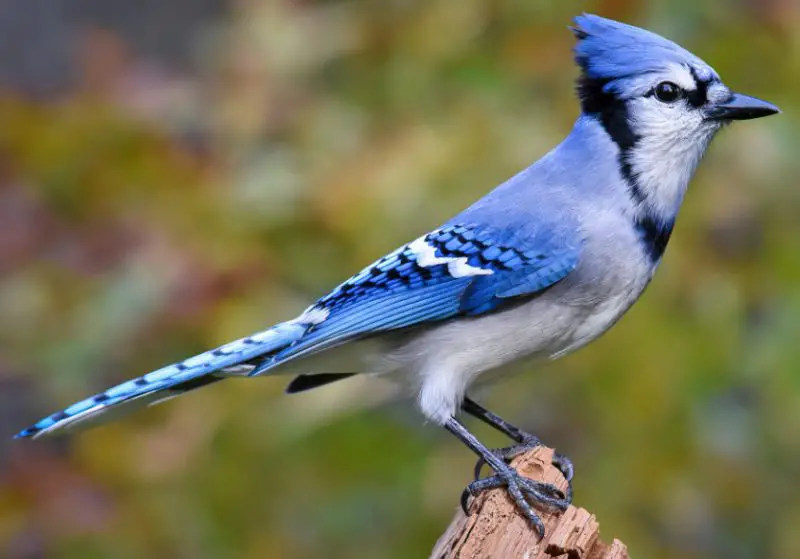
The Blue Jay is a bold and intelligent bird that stands out with its bright blue upperparts, white underparts, and black necklace across the chest. Its crest can be raised or lowered depending on mood, adding to its expressive appearance. Their wings and tail are barred with black and white, creating a striking contrast that is easily noticeable in flight.
Blue Jays typically measure 9–12 inches long with a wingspan of 13–17 inches. They are known for their loud, varied calls, including harsh “jay-jay” cries and impressive mimicry of hawks. Social and curious, they are often seen in small family groups or mixed flocks, especially during migration periods in the fall. In Massachusetts, they are year-round residents, bringing both beauty and noisy chatter to woodlands and suburban areas.
Diet-wise, Blue Jays are omnivorous, consuming acorns, nuts, seeds, fruits, and insects. They are also known for caching acorns in the soil, inadvertently aiding in forest regeneration. Their habitat ranges from forests and parks to residential neighborhoods. Adaptable and clever, they are frequent visitors to backyard feeders across Massachusetts, where they display both cooperative and sometimes aggressive behavior.
American Robin
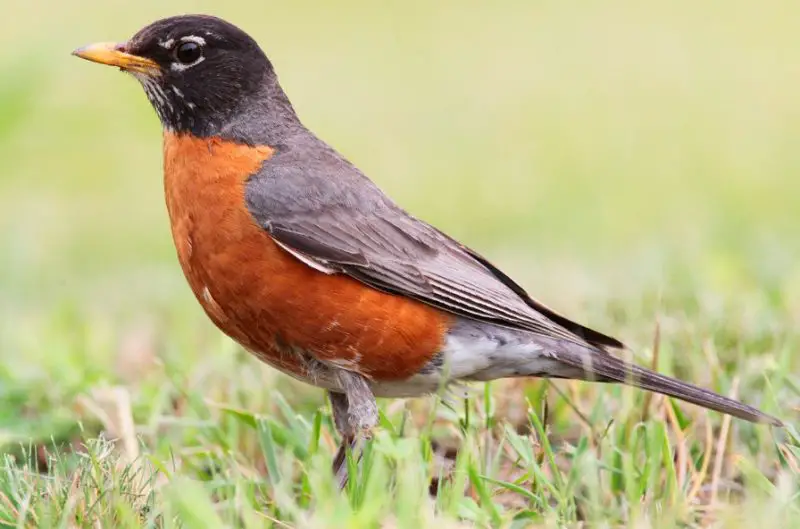
The American Robin is a familiar sight across Massachusetts, known for its bright orange breast, gray-brown back, and cheerful song that often signals the arrival of spring. Robins are medium-sized thrushes with upright postures, long legs, and slender yellow bills. Their white eye-ring and contrasting dark head help distinguish them from other thrush species.
These birds are typically 9–11 inches in length, with a wingspan of 12–16 inches. American Robins are highly visible in open spaces, hopping across lawns in search of food. They are active and alert, often pausing to listen for movement in the soil before darting their beaks into the ground to extract earthworms. Their presence in both wild and urban landscapes makes them one of the most recognized birds in the state.
The American Robin’s diet consists largely of earthworms, insects, and fruits, shifting seasonally depending on availability. They breed abundantly in Massachusetts, nesting in trees, shrubs, or even on human-made structures. While some migrate south for the winter, many remain in Massachusetts year-round, forming flocks that forage in fruit-bearing trees.
Tufted Titmouse
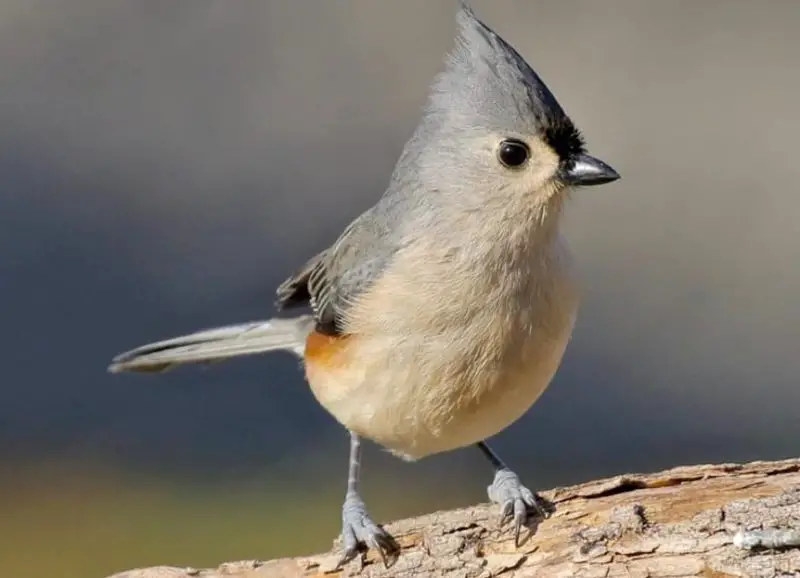
The Tufted Titmouse is another small songbird commonly seen in Massachusetts. It is easily identified by its gray plumage, white underparts, rust-colored flanks, and a small crest on its head. Its large black eyes and strong bill give it a lively and inquisitive appearance, making it a regular visitor to backyard feeders.
This species measures 5.5–6.3 inches long, with a wingspan of 7.9–10.2 inches. Tufted Titmice are vocal birds, often heard before they are seen, producing loud “peter-peter-peter” calls that carry through the woods. They are agile foragers, frequently hanging upside down to probe leaves, branches, and bark for insects and seeds.
Their diet is varied, including insects, seeds, nuts, and berries, making them adaptable to seasonal changes in Massachusetts. They prefer deciduous and mixed forests but are equally at home in suburban gardens with ample tree cover. Year-round residents, Tufted Titmice often travel in small mixed-species flocks during the non-breeding season, enhancing their survival through cooperative foraging.
Mourning Dove

The Mourning Dove is a graceful and slender bird, distinguished by its soft gray-brown plumage, long pointed tail edged with white, and subtle black spots on its wings. Its mournful cooing call gives the species its name and is a familiar sound in Massachusetts, especially during the warmer months.
Mourning Doves measure 9–13 inches in length with wingspans of 17–18 inches. They have small heads, delicate bills, and streamlined bodies built for fast, direct flight. Their wings make a distinctive whistling sound when they take off, which serves as an alarm signal. Despite their gentle appearance, they are strong fliers, capable of reaching speeds up to 55 miles per hour.
These doves primarily feed on seeds, which they forage from the ground in open areas such as fields, roadsides, and lawns. They adapt well to human presence and are often seen perched on wires, rooftops, or feeding under backyard bird feeders. In Massachusetts, Mourning Doves are common year-round residents, nesting in trees, shrubs, and sometimes even on man-made structures.
American Goldfinch
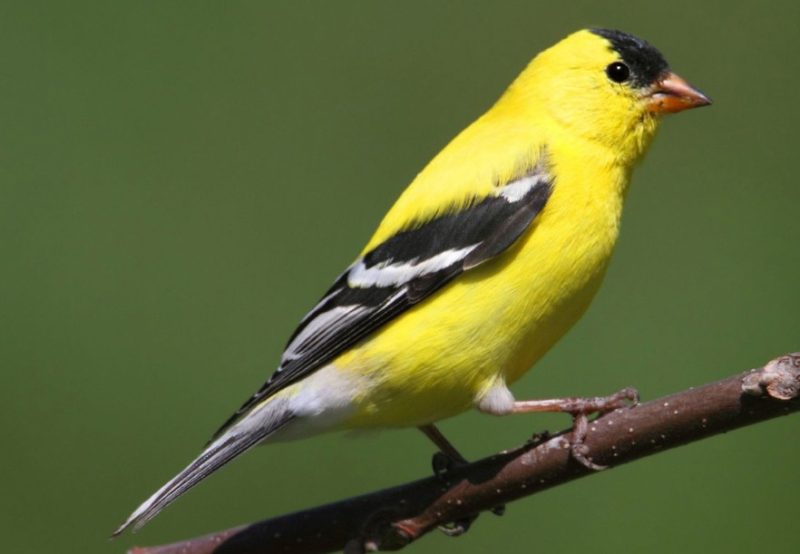
The American Goldfinch is a small and vibrant songbird that adds a splash of color to Massachusetts landscapes, especially in the summer. Males are easily identified by their bright lemon-yellow plumage, black wings with white markings, and a black cap on the forehead. Females and winter males are more subdued, with olive-brown feathers that provide camouflage in colder months. Their small size, conical bill, and cheerful appearance make them frequent visitors to backyard feeders.
Measuring about 4.3–5.1 inches long with a wingspan of 7.5–8.7 inches, American Goldfinches are agile fliers and highly vocal. Their flight pattern is distinctive, marked by an undulating, bouncy motion accompanied by a lively “per-chick-o-ree” call. During the breeding season, males display their bright plumage and engaging songs to attract mates and defend their territories.
The American Goldfinch primarily feeds on seeds, with a strong preference for thistle, sunflower, and dandelion seeds. Unlike many other songbirds, they breed late in the summer, coinciding with the peak abundance of seed-producing plants. They thrive in weedy fields, meadows, suburban gardens, and open woodlands across Massachusetts, and they remain in the state year-round, though some populations may move south during severe winters.
House Finch
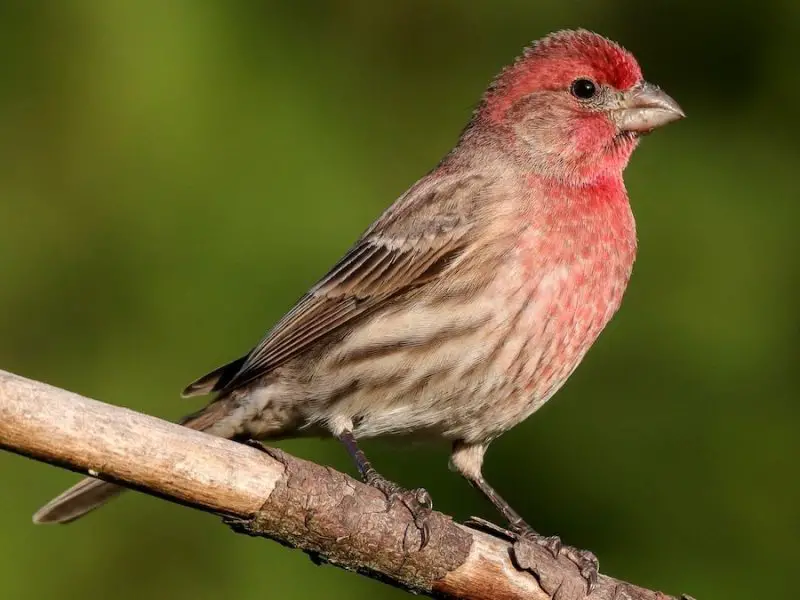
The House Finch is a familiar bird across Massachusetts, often spotted in urban and suburban areas where they thrive around human presence. Males are notable for their rosy-red plumage on the head, throat, and chest, contrasting with streaky brown bodies. Females lack the red coloring and are more uniformly brown with streaked underparts, making them harder to identify without close observation.
Typically measuring 5–6 inches long with wingspans of 8–10 inches, House Finches have a conical bill suited for cracking seeds. Their song is a cheerful, warbling mix of notes delivered from exposed perches or while in flight. They are highly social birds, often seen in flocks at feeders or perching together on wires and shrubs. Their adaptability has allowed them to expand widely across the United States.
House Finches feed largely on seeds, fruits, and buds, with sunflower seeds being a favorite at backyard feeders. They nest in trees, bushes, or even on building ledges and hanging planters in residential areas. In Massachusetts, they are year-round residents, commonly found in both rural farmlands and city neighborhoods. Their friendly nature and musical calls make them one of the most welcomed backyard birds.
Song Sparrow
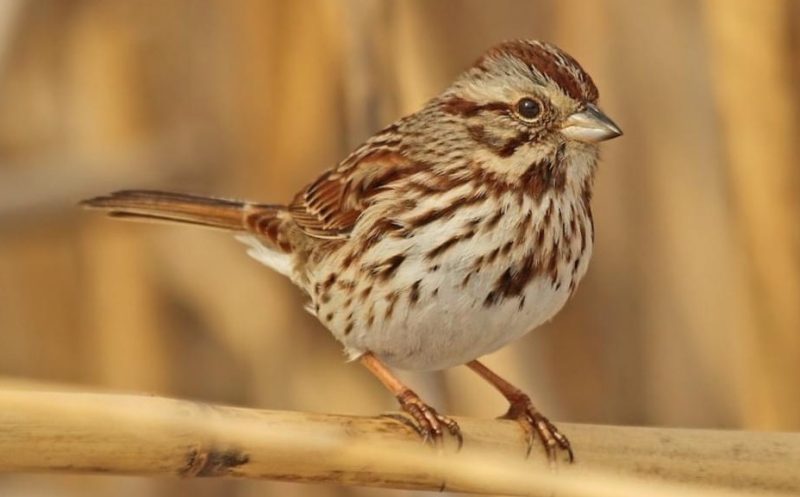
The Song Sparrow is one of the most widespread and easily recognized sparrows in Massachusetts. It has streaky brown plumage with a gray face, a central dark spot on the breast, and a relatively long tail. Its modest appearance is complemented by its rich and varied song, which often includes a series of cheerful, musical phrases.
Song Sparrows measure around 5–7 inches long with a wingspan of 7–9 inches. Their songs play an important role in defending territories and attracting mates, and males are particularly vocal during the breeding season. Despite their small size, they are hardy and adaptable, capable of surviving harsh winters in the region.
Their diet consists mainly of seeds and insects, which they forage on the ground or among low vegetation. They inhabit a wide range of habitats across Massachusetts, including marshes, fields, forest edges, and suburban gardens. Year-round residents, Song Sparrows are among the most commonly observed sparrows at bird feeders, where they mix with other seed-eating birds during the colder months.
White-throated Sparrow
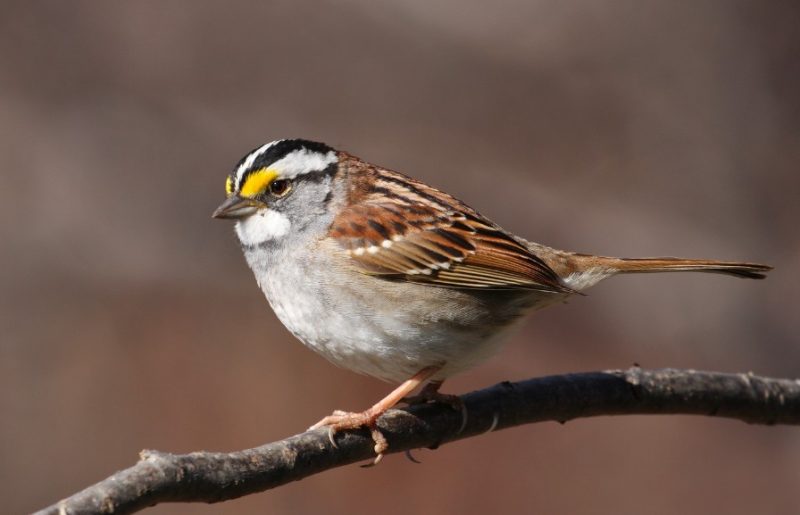
The White-throated Sparrow is a striking and easily identified bird, with its crisp white throat, black-and-white striped crown, and bright yellow patches between the bill and eyes. Some individuals display tan stripes instead of white, but all share the distinctive throat marking. Their soft whistles, sounding like “Oh-sweet-Canada-Canada,” are commonly heard in Massachusetts woodlands.
These sparrows are medium-sized, measuring 6–7 inches long with a wingspan of 8–9 inches. They are ground-foraging birds, often scratching in the leaf litter in search of food. White-throated Sparrows are known for their social behavior, frequently gathering in small flocks during migration and winter. Their calls and whistles are one of the most recognizable sounds of spring and fall birdwatching.
Their diet consists of seeds, fruits, and insects, depending on the season. White-throated Sparrows breed in northern forests of Canada but migrate south to spend the winter in Massachusetts. They are especially common in wooded areas, thickets, and residential yards during the colder months, where they forage beneath feeders alongside other sparrows and finches.
Dark-eyed Junco
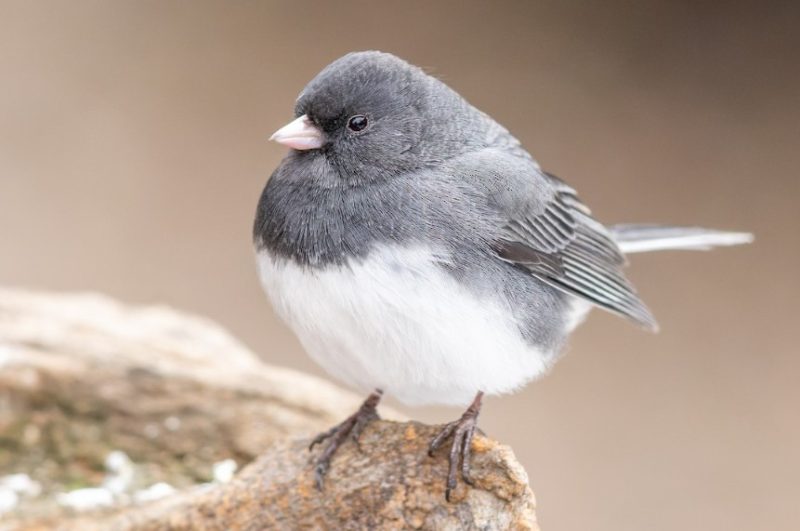
The Dark-eyed Junco, often called the “snowbird,” is a winter visitor to Massachusetts and one of the most abundant sparrows in North America. They are characterized by their slate-gray upperparts, white underparts, and a distinct white outer tail that flashes in flight. Females and immature birds often appear more brownish, but the crisp contrast of dark and white is a key identification feature.
Dark-eyed Juncos measure 5–6.5 inches in length with wingspans of 7–10 inches. They are highly active ground-feeders, often seen hopping and scratching beneath bird feeders or along woodland edges. Their calls are simple “ticking” sounds, while their songs are a trilling series of notes. Juncos are flocking birds, frequently appearing in groups during the winter months.
These birds feed primarily on seeds, supplemented by insects during the breeding season. While they breed in northern forests and higher elevations, they migrate south to Massachusetts during the winter, becoming a familiar presence in backyards and open woodlands. Their arrival is often associated with the first snowfalls, making them a seasonal favorite for birdwatchers.
Red-winged Blackbird
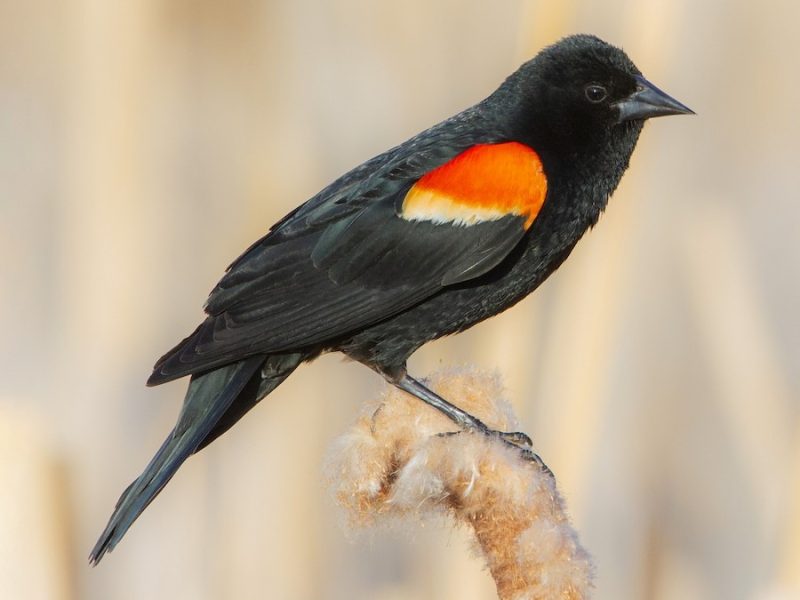
The Red-winged Blackbird is one of the most distinctive and widespread blackbirds in Massachusetts, especially in wetlands and marshy areas. Males are easily identified by their glossy black plumage and bright red and yellow shoulder patches, which they display prominently during courtship and territorial defense. Females, on the other hand, are streaked brown and resemble large sparrows, making them less conspicuous.
These birds are medium-sized, measuring 6.7–9.1 inches in length with a wingspan of 12–16 inches. Males are highly territorial during the breeding season, often perching on cattails or shrubs to sing their characteristic “conk-la-ree” song. Flocks of Red-winged Blackbirds can number in the thousands outside the breeding season, forming one of the most impressive avian spectacles in North America.
Red-winged Blackbirds feed on insects, seeds, and grains, with their diet shifting seasonally. They prefer wetland habitats but are also found in fields, meadows, and agricultural lands. In Massachusetts, they are abundant during the spring and summer, breeding in marshes and open grasslands, before forming large migratory flocks that head south in winter.
Common Grackle

The Common Grackle is a large, striking blackbird often seen in Massachusetts, notable for its glossy plumage that shines with iridescent hues of blue, purple, and green in sunlight. Its long, keel-shaped tail and pale yellow eyes give it a piercing expression that sets it apart from other blackbirds. In flight, grackles display stiff wingbeats and a slightly awkward style, yet they are strong fliers capable of traveling long distances in flocks.
Measuring 11–13 inches in length with wingspans of 14–18 inches, Common Grackles are among the largest blackbirds in North America. Their harsh, squeaky calls are distinctive and often echo from treetops and power lines where they gather in noisy groups. During the breeding season, males puff out their feathers and spread their tails to display dominance and attract mates.
These birds are omnivorous, feeding on seeds, insects, small vertebrates, and even human food scraps. They forage both on the ground and in shallow water, often raiding agricultural fields for grains. In Massachusetts, they are common in open woodlands, farmlands, suburban areas, and wetlands, often forming large migratory flocks in spring and fall.
European Starling
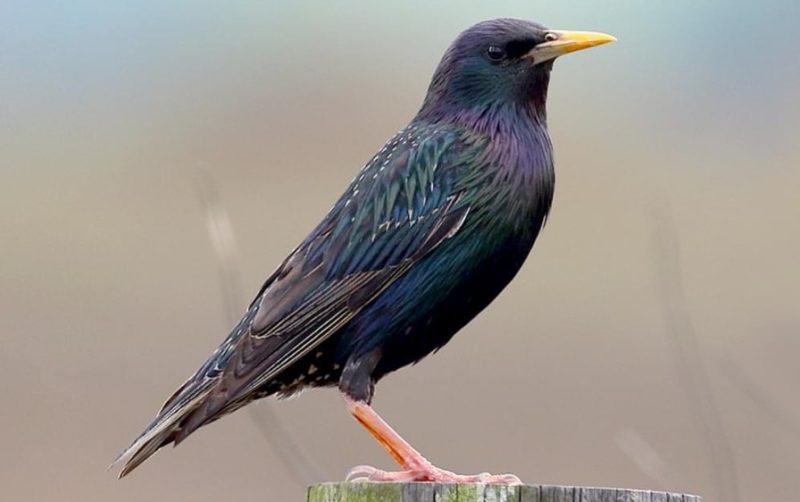
The European Starling is a non-native bird introduced to North America, now thriving across Massachusetts in large numbers. Adults are glossy black with iridescent purple and green tones that shimmer in the sunlight, while their plumage becomes speckled with white spots during winter. Their long, pointed yellow bill in summer and darker bill in winter make them easy to identify.
European Starlings measure about 7.5–9 inches long with wingspans of 12–17 inches. They are highly social, often gathering in huge flocks called murmurations, which move in breathtaking synchronized patterns across the sky. Their vocal abilities are impressive, as they can mimic the songs of other birds, mechanical noises, and even human sounds.
Their diet is varied, consisting of insects, worms, fruits, and grains, making them highly adaptable to different habitats. Starlings nest in cavities, often competing with native species such as bluebirds and woodpeckers for nesting sites. In Massachusetts, they are abundant in cities, suburbs, and farmlands, where they are both admired for their beauty and considered pests for their invasive habits.
Eastern Bluebird
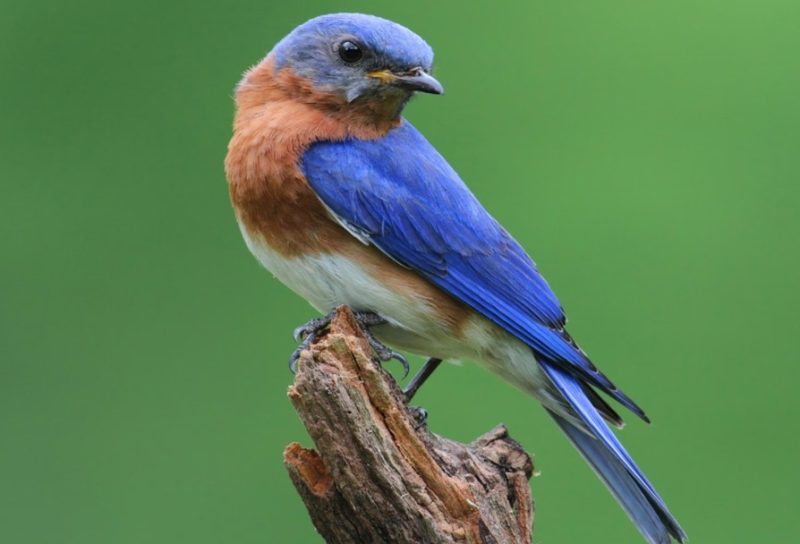
The Eastern Bluebird is one of Massachusetts’ most beloved songbirds, easily recognized by its brilliant blue upperparts and warm reddish-orange breast. Females are paler with more subdued colors, but both sexes share the same graceful posture and sweet expression. Their gentle calls and melodious songs often brighten open fields, orchards, and meadows in spring and summer.
Eastern Bluebirds are medium-sized thrushes, measuring 6.3–8.3 inches long with wingspans of 9.8–12.6 inches. They are cavity-nesters, relying on natural tree holes or nest boxes, and are frequently seen perched on fence posts or wires scanning for insects. During courtship, males perform fluttering flights and present nesting materials to attract females.
Their diet is primarily insect-based in summer, including beetles, grasshoppers, and caterpillars, while fruits and berries sustain them in fall and winter. Once in decline due to habitat loss and competition from starlings and sparrows, Eastern Bluebirds have made a strong comeback in Massachusetts thanks to nest box programs. They are now a regular sight in open countryside, parks, and suburban areas.
House Sparrow
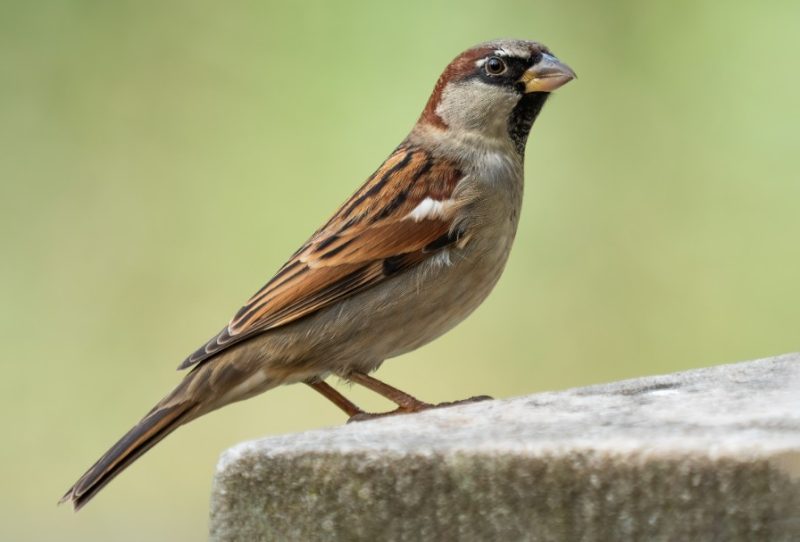
The House Sparrow is one of the most familiar birds in Massachusetts, introduced from Europe and now abundant in towns and cities across the state. Males are identified by their gray heads, chestnut-brown napes, and black bibs on their throats, while females and young birds are plainer with buffy-brown plumage and lighter undersides. Despite their modest appearance, they are lively and social birds.
House Sparrows measure 5.9–6.7 inches long with wingspans of 7.5–9.8 inches. Their cheerful chirping is a common sound in urban and suburban neighborhoods, where they gather in flocks around buildings, gardens, and outdoor dining areas. They are aggressive competitors for nesting cavities and often displace native species such as bluebirds and tree swallows.
Their diet includes seeds, grains, insects, and food scraps, making them well-suited for living near humans. They readily nest in crevices, vents, and man-made structures, thriving in environments that many native birds avoid. In Massachusetts, House Sparrows are present year-round and are among the most frequently observed birds in both rural and urban areas.
Downy Woodpecker
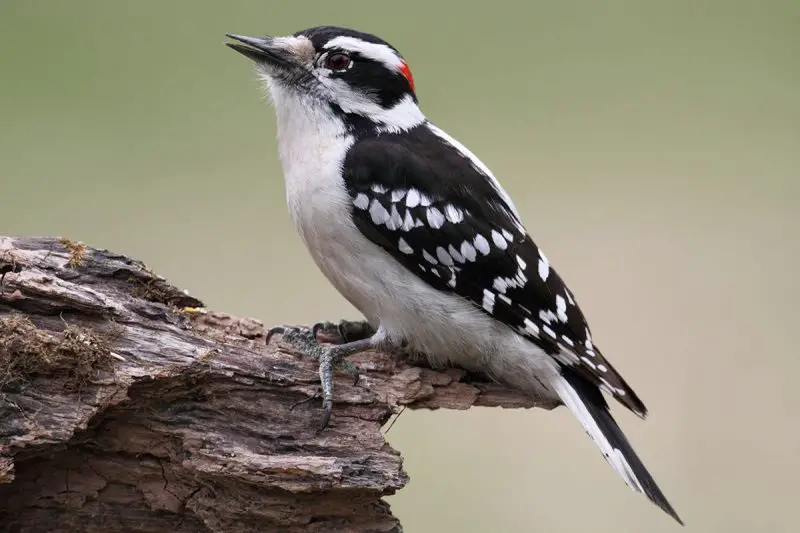
The Downy Woodpecker is the smallest woodpecker in North America and a common resident of Massachusetts woodlands and backyards. It is easily recognized by its black-and-white checkered wings, white underparts, and small bill. Males have a small red patch on the back of the head, while females lack this marking. Their petite size and cheerful behavior make them frequent feeder visitors.
Measuring 5.5–6.7 inches long with wingspans of 9.8–11.8 inches, Downy Woodpeckers are agile and active, often clinging to thin branches and plant stems. Their drumming on tree trunks serves as both a communication method and a way to excavate insects. They are also known to join mixed winter flocks with chickadees, nuthatches, and titmice, benefiting from group vigilance against predators.
Downy Woodpeckers feed on insects, larvae, seeds, and berries. They are particularly helpful in controlling insect populations, making them beneficial to forest ecosystems. In Massachusetts, they inhabit forests, orchards, suburban yards, and parks throughout the year. Their adaptability and willingness to visit suet feeders ensure that they are one of the most commonly encountered backyard birds in the state.
Hairy Woodpecker
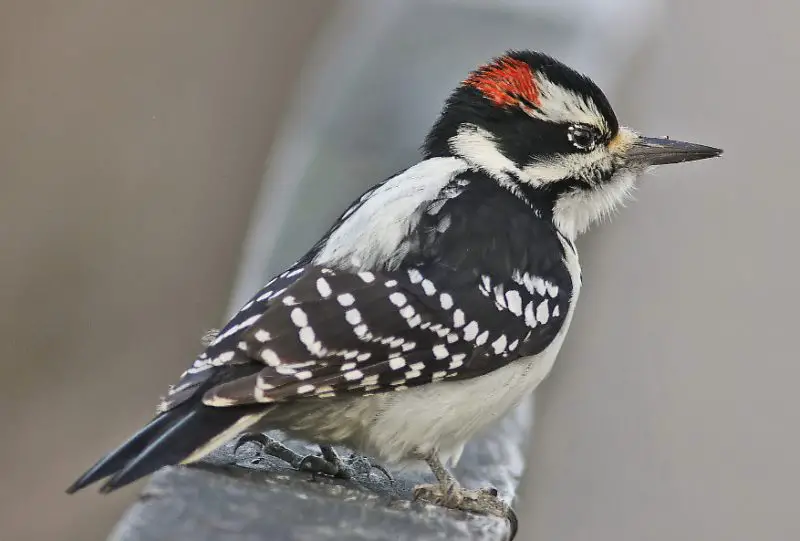
The Hairy Woodpecker is a close relative of the Downy Woodpecker but larger in size, with a longer, sturdier bill. It shares the same black-and-white plumage pattern, with males showing a small red patch on the back of the head. At a glance, Hairy and Downy Woodpeckers look nearly identical, but the Hairy’s bill length is nearly as long as its head, serving as a key identification feature.
This species measures 7–10 inches long with wingspans of 13–16 inches, making it noticeably bigger than the Downy. Hairy Woodpeckers are strong foragers, hammering into tree trunks with loud, deliberate strikes. Their drumming is louder than that of the Downy, and their calls are sharper, helping birdwatchers distinguish between the two.
Their diet consists mainly of insects such as beetle larvae, ants, and caterpillars, supplemented by seeds and fruits. They prefer mature forests but also adapt to suburban areas with tall trees. In Massachusetts, they are year-round residents and frequent suet feeders, though they are less common than the smaller Downy Woodpecker. Their preference for larger trees makes them more frequently observed in woodlands and forest edges.
Red-bellied Woodpecker
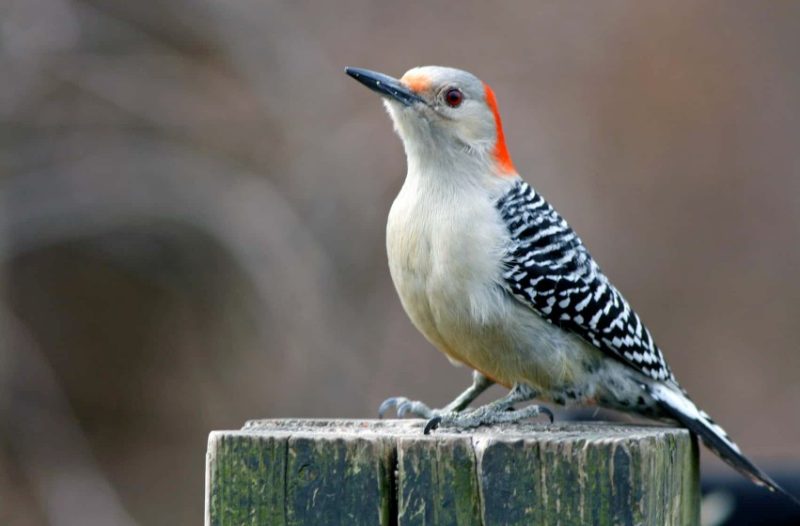
The Red-bellied Woodpecker is a striking bird with a pale, lightly barred back and a distinctive red cap that extends from its bill to the nape in males, while females display red only on the nape and crown. Despite its name, the red belly is often faint and hard to see, usually visible only when the bird is in flight or perched at a particular angle. Medium-sized, these woodpeckers measure around 9 to 10.5 inches in length with a wingspan between 13 and 17 inches.
They are known for their loud, rolling calls and drumming behavior, which they use to establish territories and attract mates. Red-bellied Woodpeckers are highly active foragers, often clinging to tree trunks and branches as they probe bark crevices for insects, spiders, and larvae. They also feed on fruits, nuts, and seeds, frequently caching food in tree cavities to eat later. Their versatility in diet allows them to thrive year-round in Massachusetts.
This species prefers mixed forests, woodlots, and suburban areas with mature trees. In Massachusetts, they are increasingly common, particularly in the eastern and central regions where woodlands meet residential areas. Their adaptability to both rural and urban settings makes them one of the more noticeable woodpeckers in the state.
Northern Flicker

The Northern Flicker is one of the most distinctive woodpeckers, notable for its brown plumage with black barring on the back and large black spots on the belly. In Massachusetts, the “yellow-shafted” form is most common, showing a bright yellow hue under the wings and tail. They also feature a black crescent-shaped patch across the chest and a white rump that is highly visible in flight. Adults typically range from 11 to 14 inches long with wingspans up to 21 inches.
Unlike many other woodpeckers, Northern Flickers spend much of their time on the ground, where they forage for ants and beetles, their primary food source. Their long, barbed tongues are perfectly adapted for extracting insects from soil and crevices. They also consume seeds, berries, and nuts, especially during winter when insect prey is scarce. Their loud “wick-a-wick” calls and rhythmic drumming are common sounds in Massachusetts woodlands.
They inhabit open forests, woodland edges, and fields interspersed with scattered trees. In Massachusetts, Northern Flickers are found throughout the state during the breeding season and are partial migrants, with some staying year-round and others moving south for the winter. Their adaptability to a variety of habitats ensures their continued presence across the region.
Pileated Woodpecker
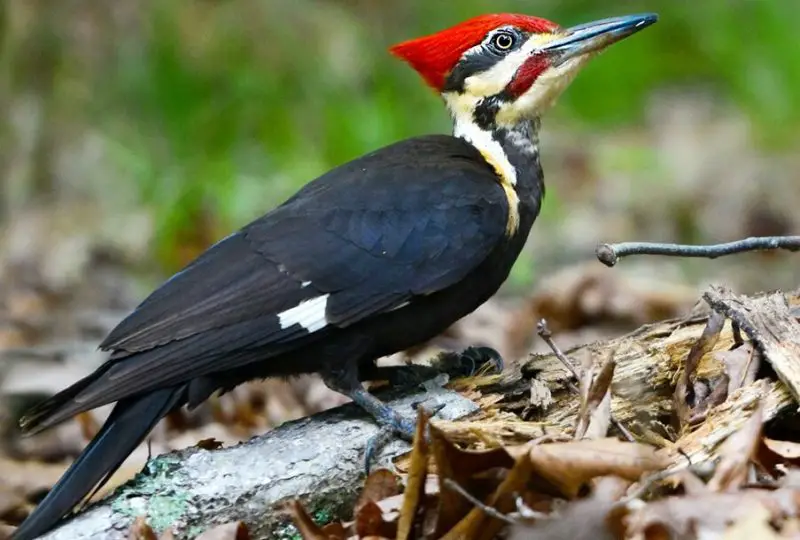
The Pileated Woodpecker is the largest woodpecker in Massachusetts and one of the most impressive birds in the state. Recognizable by its crow-like size, striking black body, bold white wing patches, and flaming red crest, this bird can measure up to 19 inches long with a wingspan reaching nearly 30 inches. Both males and females are striking, though males show a red stripe on the cheek.
Their powerful beaks allow them to excavate large rectangular holes in trees, which they use to find carpenter ants, beetle larvae, and other wood-boring insects. These feeding holes are so large and deep that they create vital habitat for other wildlife, such as owls, bats, and small mammals. Pileated Woodpeckers also consume wild fruits and nuts, making them key contributors to the forest ecosystem.
They are typically found in mature forests, especially areas with tall, dead, or decaying trees. In Massachusetts, Pileated Woodpeckers are widespread but most commonly observed in large forest tracts in central and western parts of the state. Their loud, resonant calls and vigorous drumming often reveal their presence long before they are seen.
Carolina Wren
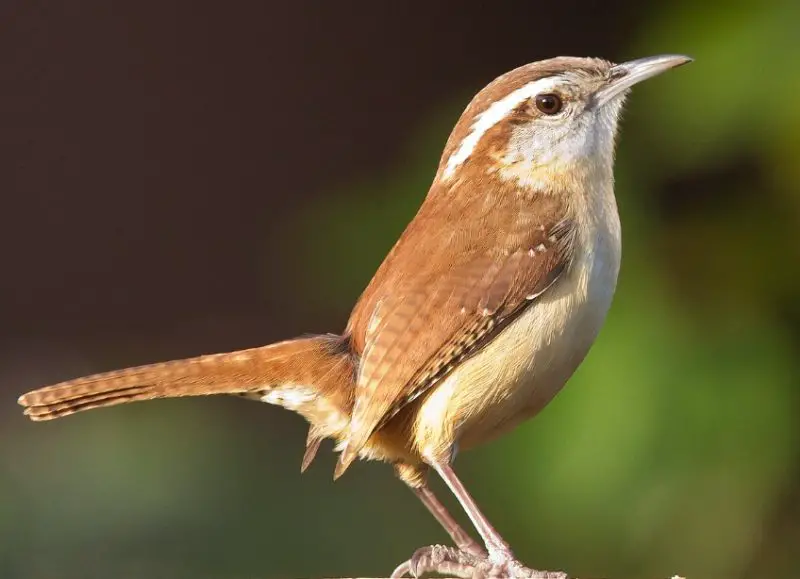
The Carolina Wren is a small but bold bird with a rich, rusty-brown body, buff-colored underparts, and a prominent white eyebrow stripe. Its slightly curved bill and cocked tail are useful identification features. Despite its small size, measuring about 5 to 5.5 inches long with an 11-inch wingspan, the Carolina Wren has a loud and powerful voice.
Known for their energetic behavior, these wrens are highly active foragers, often searching for insects, spiders, and small invertebrates among leaf litter, logs, and shrubbery. They are also known to consume seeds and berries, especially in colder months. Their distinctive “teakettle-teakettle-teakettle” song resonates strongly in Massachusetts backyards, woodlands, and parks.
Carolina Wrens favor dense underbrush, forest edges, and suburban gardens with thick vegetation. Once limited by cold winters, their range has expanded northward, and they now reside year-round in Massachusetts. Though harsh winters can temporarily reduce their numbers, these resilient birds bounce back quickly thanks to their adaptability.
Gray Catbird
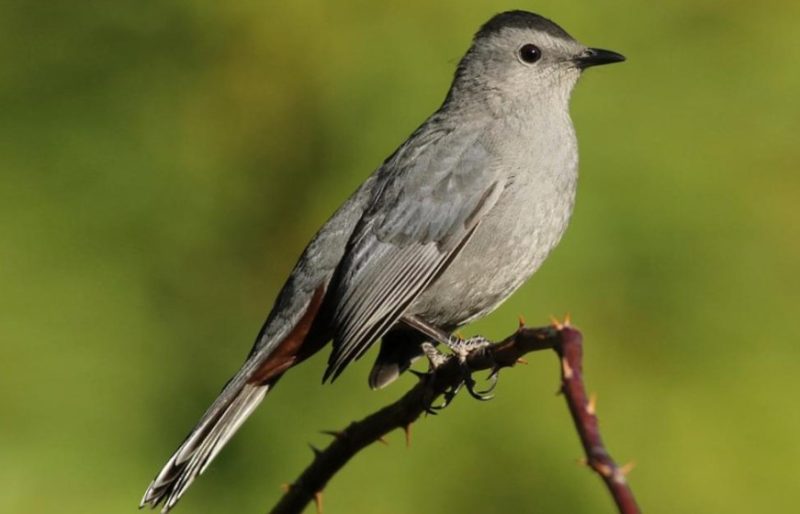
The Gray Catbird is a medium-sized songbird with sleek slate-gray plumage, a black cap, and a rusty patch beneath the tail. They are named for their cat-like “mew” calls, though they also produce a wide variety of mimicked sounds, including other birds’ songs and mechanical noises. Adults measure about 8.5 to 9 inches long with a wingspan of 11 inches.
Active and secretive, catbirds spend much of their time in dense shrubs and thickets, where they forage for insects, berries, and fruits. They are excellent mimics and accomplished singers, often stringing together long, complex songs filled with varied notes. During summer, they feed heavily on insects and spiders, shifting to more fruits and berries as autumn approaches.
Gray Catbirds thrive in habitats with dense, tangled vegetation, including forest edges, overgrown fields, and suburban yards. In Massachusetts, they are common breeding birds during spring and summer, migrating southward in winter. Their preference for shrubby landscapes makes them a frequent visitor to backyard feeders stocked with fruit or suet.
American Crow
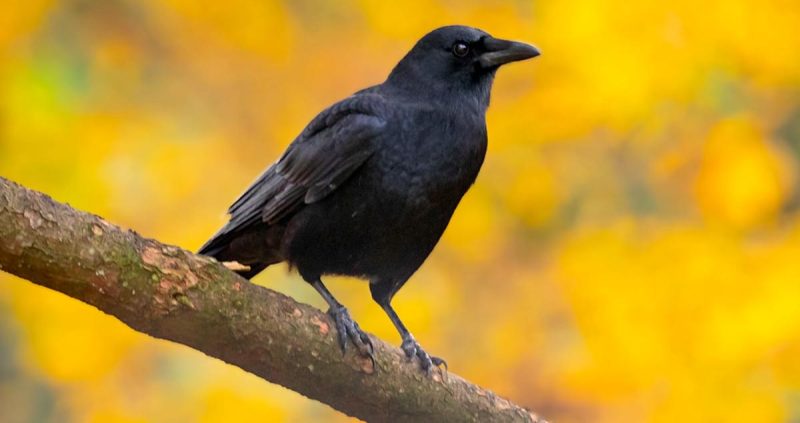
The American Crow is one of the most intelligent and adaptable birds in Massachusetts. Glossy black with strong bills and fan-shaped tails, these large birds measure about 16 to 20 inches long with wingspans up to 39 inches. Their loud “caw-caw” calls and flocking behavior make them highly recognizable across the state.
Crows are opportunistic feeders with an omnivorous diet that includes insects, small animals, carrion, seeds, fruits, and human food scraps. Their problem-solving abilities and memory are well-documented, and they are known to use tools and even recognize individual human faces. Crows often forage in groups, and their communal roosts can number in the thousands, particularly in winter.
They inhabit nearly every type of environment, from forests and farmland to cities and coastal areas. In Massachusetts, American Crows are abundant year-round residents. Their adaptability to both wild and urban landscapes has allowed them to thrive despite human development, making them one of the most familiar and widespread birds in the state.
Fish Crow
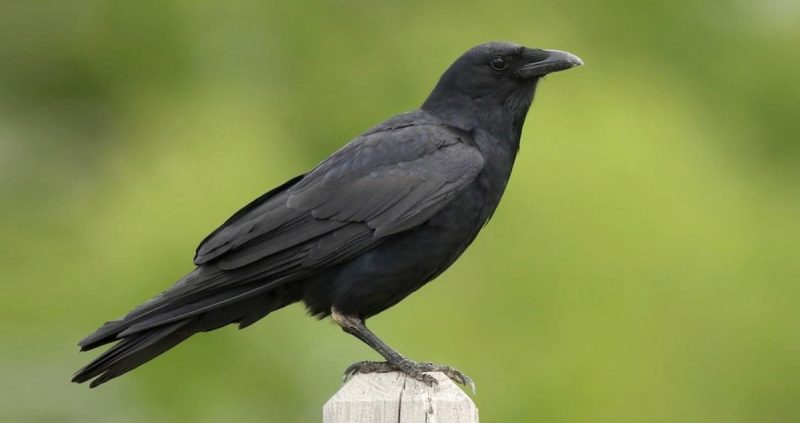
The Fish Crow is a smaller relative of the American Crow, distinguished by its nasal “uh-uh” call, which is its most reliable identification feature. It has glossy black plumage with hints of purple and green in the sunlight, making it visually similar to the American Crow. Its wings are relatively broad, and it has a slightly shorter tail compared to its larger cousin.
This species is highly adaptable and is often seen near waterways, coastlines, and urban areas. Fish Crows are opportunistic feeders, consuming everything from carrion and garbage to small crustaceans and insects. Their versatility allows them to thrive in both natural and human-dominated environments.
During flight, Fish Crows display deep wingbeats and frequent glides, often traveling in small groups. They are also highly social, sometimes joining mixed flocks with American Crows, making visual identification alone difficult. Vocalizations remain the best way to tell them apart in the field.
These crows are found throughout the eastern United States, particularly near marshes, rivers, and beaches. Their association with aquatic environments is stronger than that of American Crows, which explains their name and foraging habits.
Common Raven
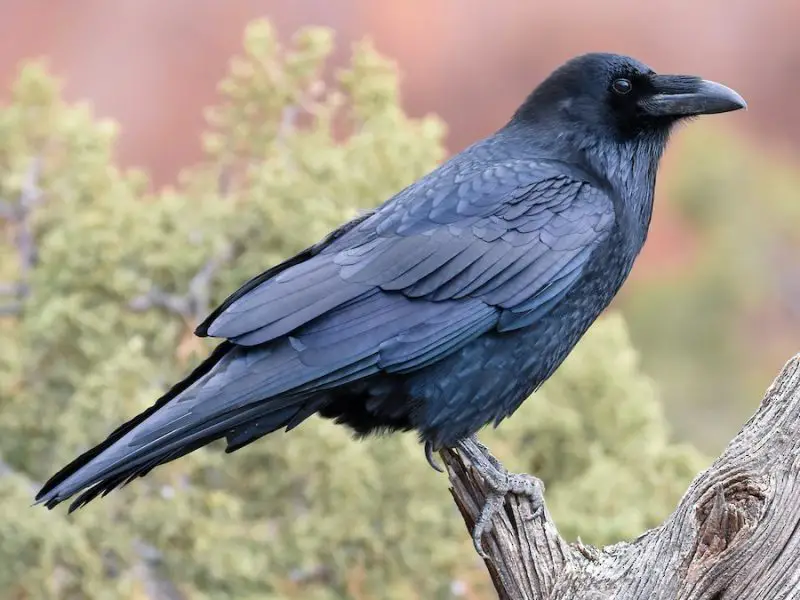
The Common Raven is the largest member of the crow family, with a heavy bill, wedge-shaped tail, and massive wings. Its glossy black feathers often show a blue or purple sheen in bright light, and its shaggy throat feathers give it a rugged appearance. Ravens are known for their intelligence and problem-solving skills, often ranking among the smartest birds in the world.
Their deep, resonant “croak” call easily separates them from crows. In flight, they soar with slow wingbeats, sometimes performing aerial acrobatics such as rolls and dives. Their long wings and wedge-shaped tails make them graceful fliers, especially in mountainous or coastal areas where they ride thermals.
Ravens are opportunistic omnivores, feeding on carrion, insects, grains, berries, and even small animals. They are also known for caching food and using tools to access hard-to-reach meals. This adaptability has enabled them to thrive in habitats ranging from deserts and forests to tundra and cliffs.
These birds are most often found in remote areas compared to the more urban-adapted crows. They inhabit the northern and western parts of the United States, with populations also present in the Appalachian Mountains and parts of New England.
Barn Swallow
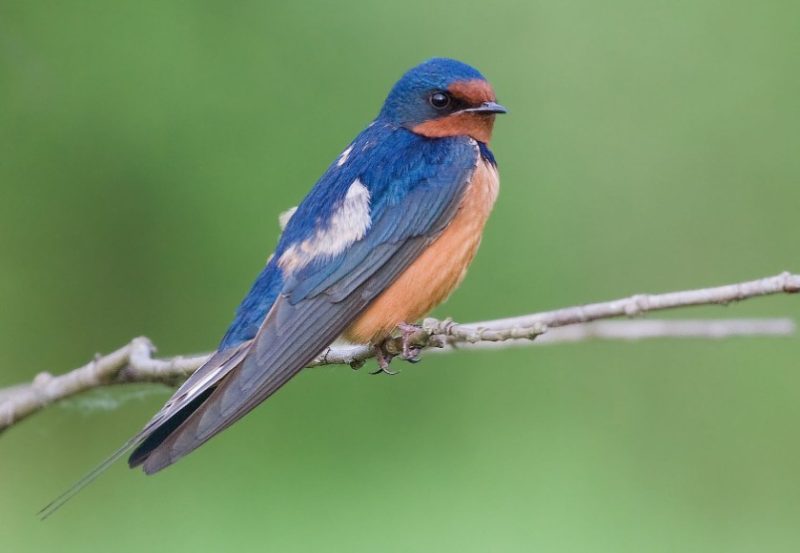
The Barn Swallow is one of the most easily recognized swallows, thanks to its deeply forked tail and sleek, streamlined body. Its glossy blue back contrasts with a reddish throat and buffy underparts, giving it a colorful and elegant look. These birds are fast and agile flyers, often seen skimming low over fields, lakes, or pastures as they chase insects.
Barn Swallows are strongly associated with human settlements, nesting under barns, bridges, and other structures. Their mud nests, shaped like half-cups, are commonly found in colonies. They readily reuse old nesting sites and often return to the same area year after year.
Their song is a cheerful series of twittering notes, while their constant chattering in flight adds to the liveliness of open countryside in summer. Males perform courtship flights, displaying their long tails to attract mates. Both parents share responsibilities for raising chicks.
They are migratory birds, breeding throughout North America in summer and wintering as far south as South America. Their long-distance journeys make them one of the most widely traveled songbirds.
Tree Swallow
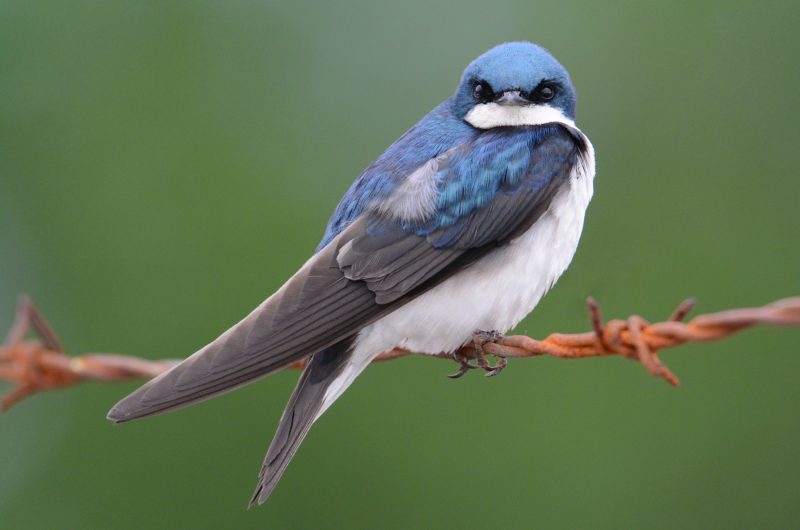
The Tree Swallow is a small, sleek bird with iridescent blue-green upperparts and clean white underparts. Its pointed wings and short, slightly notched tail give it an aerodynamic build, perfect for its swift and graceful flight. Unlike the Barn Swallow, it lacks a deeply forked tail, which helps in distinguishing between the two.
These birds are cavity nesters, often taking advantage of nest boxes provided by humans. They compete with bluebirds, chickadees, and House Sparrows for nesting spots. Their nests are lined with feathers, which Tree Swallows actively collect during breeding season.
Tree Swallows primarily eat flying insects, but they are unusual among swallows in that they can also consume berries, particularly in cold weather when insects are scarce. This dietary flexibility helps them survive early spring conditions.
They breed across much of North America, from Alaska to the eastern United States, and migrate southward to Central America and the Caribbean for winter. Large flocks can often be seen staging together before migration.
Chimney Swift
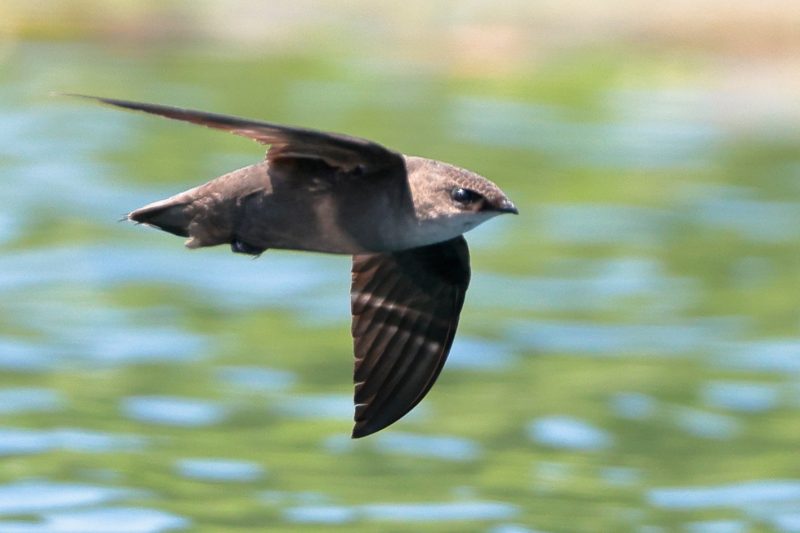
The Chimney Swift is a small, sooty-gray bird with long, narrow wings and a short, squared-off tail. Its appearance is often compared to a “flying cigar” due to its slender, cylindrical body. These birds rarely perch in the traditional sense, instead clinging vertically to walls and chimneys with their strong claws.
They spend nearly their entire lives in flight, feeding on aerial insects such as flies, mosquitoes, and beetles. Chimney Swifts are remarkable for their stamina, sometimes staying airborne for hours as they hunt. Their rapid, bat-like wingbeats make them easy to recognize in the sky.
During nesting season, they construct small cup-shaped nests of twigs glued together with saliva, usually inside chimneys or hollow trees. Historically, they relied on old-growth forests, but they have since adapted to human-made structures for breeding.
These birds breed throughout eastern North America and migrate to South America for winter. They are most abundant in towns and cities where chimneys provide safe nesting sites.
Eastern Phoebe
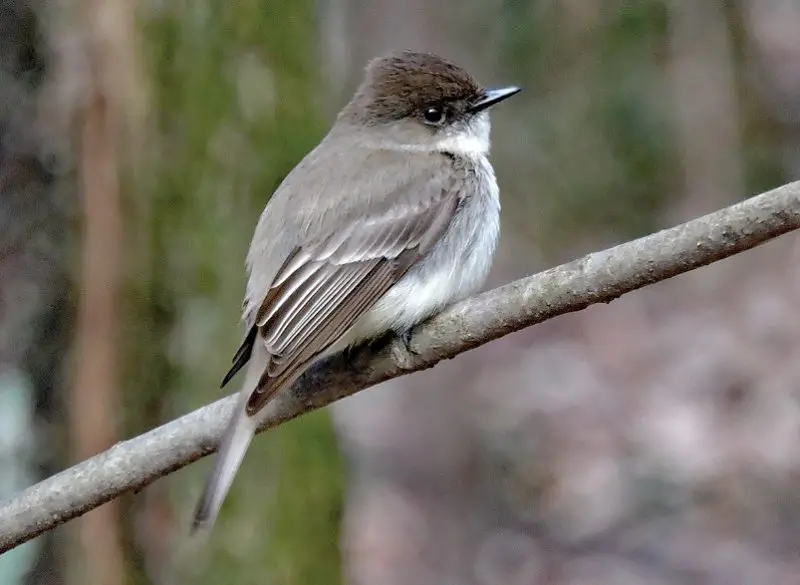
The Eastern Phoebe is a small flycatcher with a plain brownish-gray back, white underparts, and a slightly darker head. Its tail-wagging behavior is one of its most distinctive traits, often giving away its presence before its plumage does. The bird’s simple “fee-bee” song is also a key identifier, frequently heard around wooded edges and near water.
Eastern Phoebes are sit-and-wait hunters, perching quietly before sallying out to snatch flying insects. Their diet also includes spiders, berries, and other small invertebrates. They often return to the same perch multiple times while foraging.
Nesting habits are strongly tied to human structures. They often build mud-and-moss nests under bridges, eaves, or porch rafters, where they are somewhat protected from predators. They are among the first flycatchers to return in spring, signaling the change of seasons.
Their range extends across eastern North America, with breeding populations from Canada down into the southern United States. They migrate to the southeastern U.S. and Central America during winter.
Eastern Kingbird

The Eastern Kingbird is a striking flycatcher with a bold black head, white throat, and a dark gray back that contrasts with its white underparts. One of its most recognizable features is the white-tipped tail, which makes it easy to identify even in flight. This species is medium-sized and has a sturdy build, often seen perched upright on fences or open branches.
Eastern Kingbirds are aggressive defenders of their nests, known to chase away much larger birds such as hawks and crows. They primarily feed on insects, catching them midair with remarkable speed and precision. During late summer, their diet shifts to include a variety of fruits and berries.
These birds prefer open habitats such as fields, meadows, and the edges of rivers or lakes. They are often seen perched prominently in exposed areas, scanning for prey. Their harsh, electric-sounding calls add to their bold personality in the wild.
They are common summer residents across Massachusetts, especially from May to September. After the breeding season, they migrate in large groups to South America, where they spend the winter in tropical regions.
Cedar Waxwing
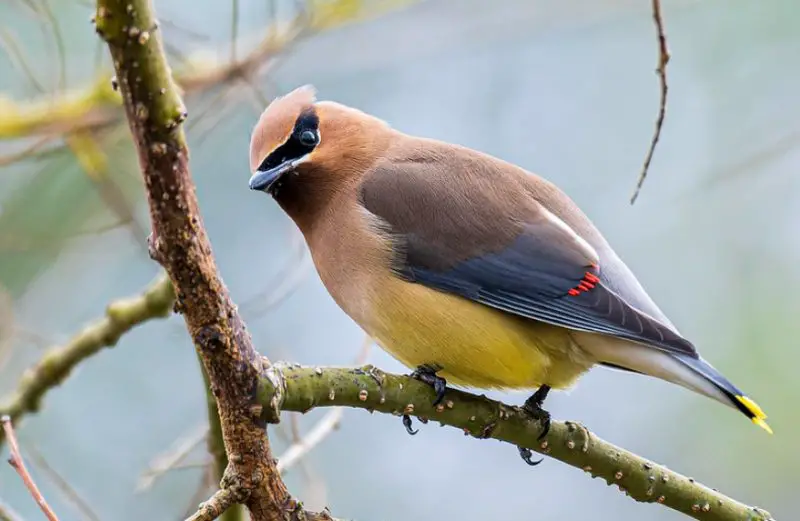
The Cedar Waxwing is one of the most elegant songbirds, easily recognized by its silky plumage, sleek crest, and a black mask outlined in white. Its body is mostly soft brown and gray, blending into pale yellow underparts. The bird also has wax-like red tips on its secondary wing feathers, which inspired its name.
Cedar Waxwings are social birds, often seen in flocks perched in trees or flying together in smooth, coordinated movements. They are primarily fruit eaters, but in summer they also feed on insects caught in midair. Their diet makes them important seed dispersers in many habitats.
These birds are often found in orchards, suburban areas with fruiting trees, and woodlands near water. Their high-pitched, thin whistles are distinctive and often heard before the birds are seen. During the breeding season, they may nest in small colonies, showing a preference for dense foliage.
In Massachusetts, Cedar Waxwings are present year-round, though they are more noticeable in late summer when they gather in large flocks near fruiting trees such as cherries, mulberries, and serviceberries.
Baltimore Oriole
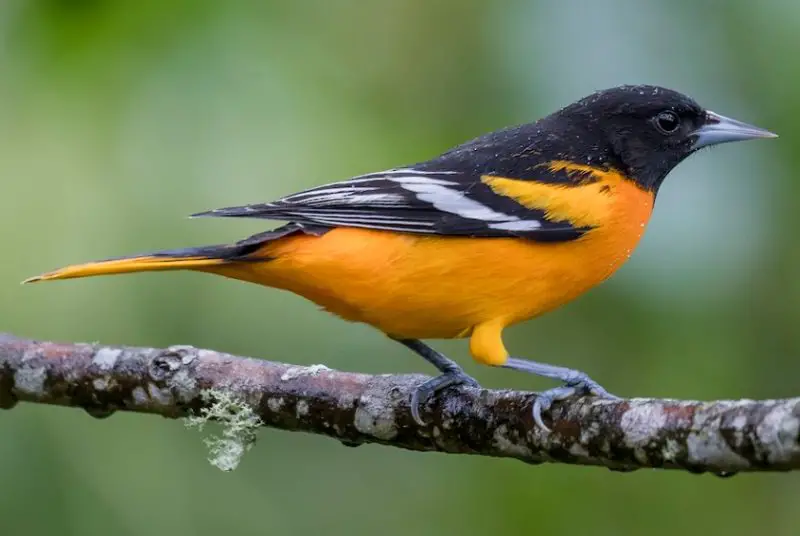
The Baltimore Oriole is a stunning bird, especially the males with their brilliant orange plumage contrasted against black wings, head, and back. Females are more subdued in color, displaying yellow-orange with grayish wings, but they share the same slim build and pointed bill. Orioles are a favorite among birdwatchers due to their vibrant appearance and melodic songs.
Their diet consists of insects, nectar, and fruit. They are often attracted to feeders offering orange slices or sugar water, much like hummingbirds. This makes them a popular backyard visitor during the warmer months.
Baltimore Orioles are known for their unique hanging nests, woven from grass and fibers, suspended from tree branches. These nests resemble small pouches and are usually placed high above the ground for protection from predators.
They are common summer residents in Massachusetts, arriving in early May and leaving by late August or September to migrate to Central and South America. Their return each spring is often seen as a sign that warmer weather has arrived.
Scarlet Tanager
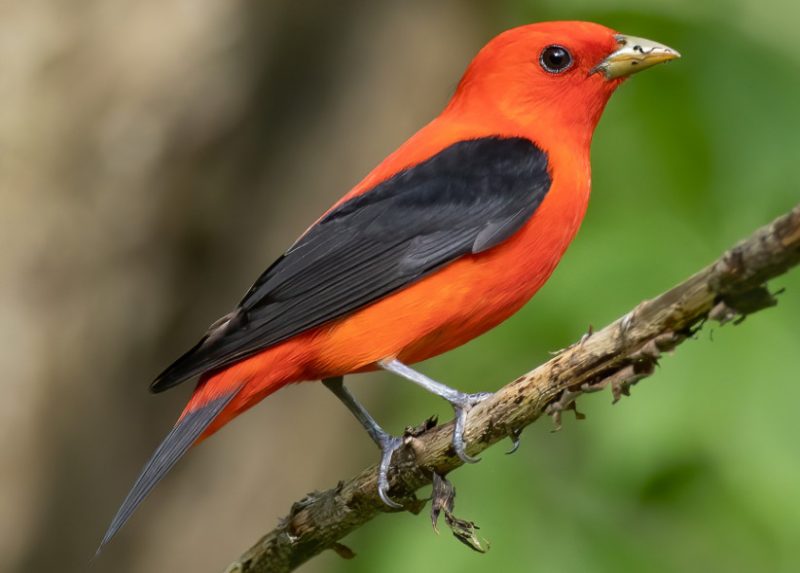
The Scarlet Tanager is one of the most striking songbirds in North America. Males are unmistakable in breeding plumage, with bright scarlet bodies and jet-black wings and tails. Females, in contrast, are olive-yellow with darker wings, which helps them stay camouflaged in forest habitats.
These birds spend much of their time high in the forest canopy, where they forage for insects, especially during summer. They also consume fruit, particularly during migration. Their diet and preference for treetop living often make them more easily heard than seen.
The song of the Scarlet Tanager is often described as similar to a robin’s but with a rougher, more burry quality. Their call note is a distinctive “chip-burr,” which helps birders locate them in dense foliage.
In Massachusetts, Scarlet Tanagers are summer breeders, most common in large tracts of deciduous or mixed forests. They arrive in May and leave by September, migrating to South America for the winter.
Indigo Bunting
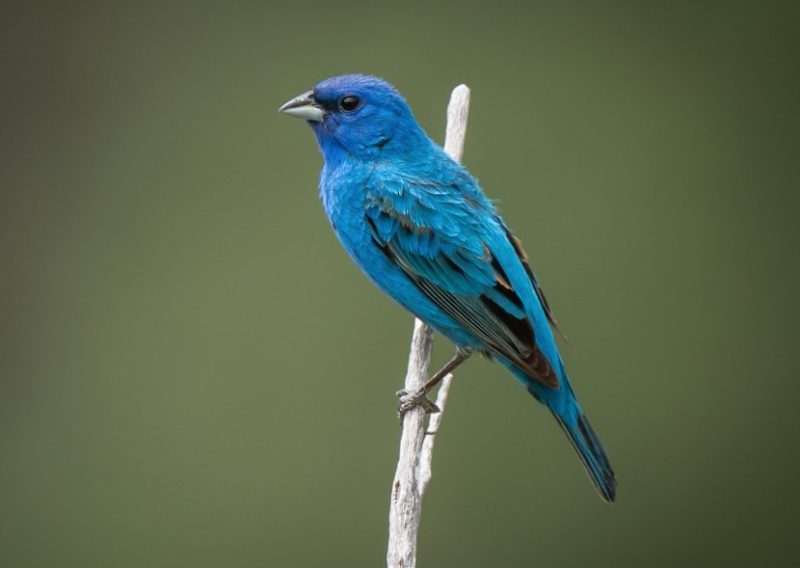
The Indigo Bunting is a small songbird admired for the male’s dazzling blue plumage during the breeding season. The blue is not from pigment but from light refraction in the feathers. Females and young birds are brown, with subtle streaking, which helps them stay inconspicuous.
Males are known for their constant singing from exposed perches during summer, filling fields and edges of forests with a cheerful warbling song. They use their songs not only to attract mates but also to defend their territory from rivals.
Indigo Buntings favor brushy fields, woodland edges, and open areas with scattered shrubs. They primarily eat insects, seeds, and berries, adapting their diet with the seasons. During fall migration, they often switch to a seed-heavy diet to build fat reserves for their journey.
In Massachusetts, Indigo Buntings are summer visitors, breeding from May through August. By September, they begin migrating south, traveling at night to reach Central America and northern South America for the winter.
Rose-breasted Grosbeak
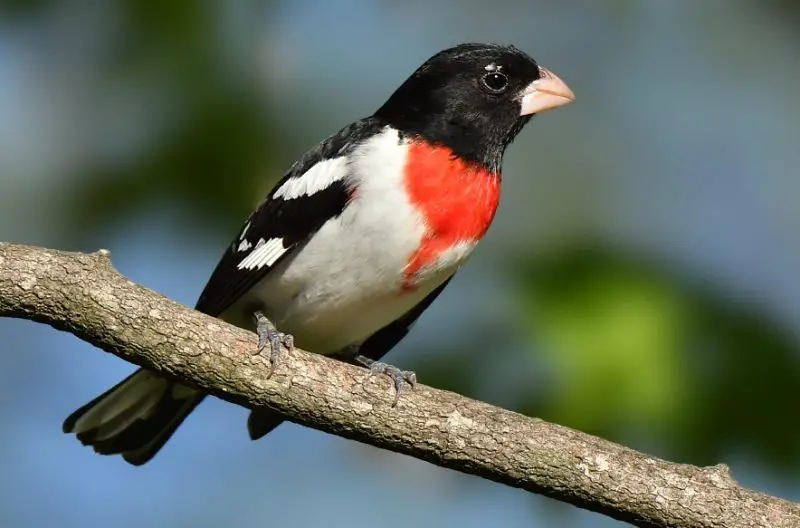
The Rose-breasted Grosbeak is a striking bird, with males displaying bold black-and-white plumage accented by a bright red triangle on the breast. Females, however, are brown and heavily streaked, resembling large sparrows, but they can be identified by their large, pale bills.
These birds are strong singers, with males producing rich, melodious songs often compared to a robin’s but more musical. Even females sing, especially during nesting season, which is less common among songbirds. Their large bills are perfectly adapted for cracking seeds, though they also eat insects and fruits.
Rose-breasted Grosbeaks prefer deciduous and mixed forests, as well as suburban yards with dense tree cover. They often visit feeders, especially those stocked with sunflower seeds. Their bold colors and sweet songs make them a favorite among bird enthusiasts.
They are summer residents in Massachusetts, arriving in early May and departing by late September. In winter, they migrate to Central and South America, where they continue to inhabit forested regions.
Ovenbird
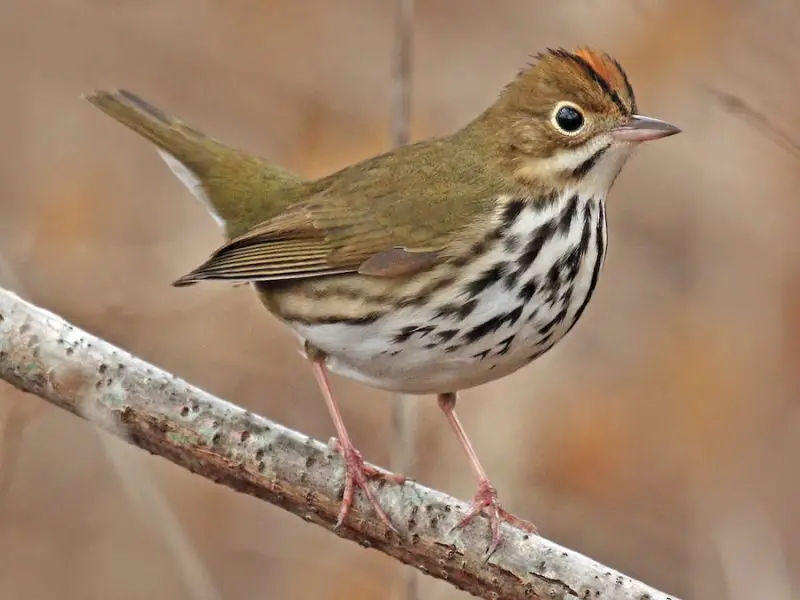
The Ovenbird is a small, stocky warbler with olive-brown upperparts and white underparts streaked with black. Its orange crown patch, bordered by black stripes, is often hidden but can be revealed when the bird is excited or agitated. True to its name, the Ovenbird builds a domed “oven-like” nest on the forest floor, well-camouflaged among leaf litter.
Ovenbirds are primarily insectivorous, feeding on ants, beetles, spiders, and other small invertebrates. They forage on the forest floor, often flipping leaves and probing the soil for hidden prey. Their loud, “teacher-teacher-teacher” song carries far above the forest understory, helping birders locate them in dense woods.
They inhabit mature deciduous and mixed forests throughout Massachusetts, often preferring shaded interiors rather than forest edges. Ovenbirds are migratory, arriving in the spring to breed and departing southward to Central America and the Caribbean for the winter.
Yellow Warbler
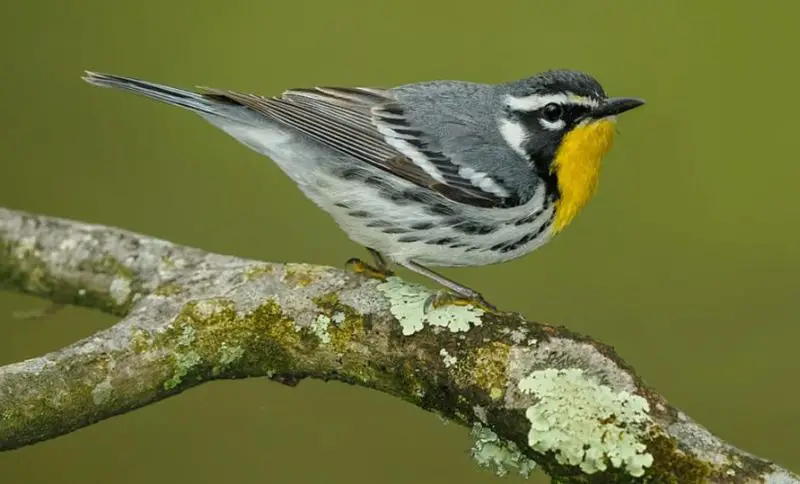
The Yellow Warbler is a small, bright songbird with vivid yellow plumage and subtle reddish streaks on its breast. Males are more brightly colored than females, with their cheerful hue making them highly visible in shrubs and trees near wetlands and streams. Their thin, pointed bills are ideal for catching insects, their primary food source.
Yellow Warblers are agile foragers, gleaning insects from leaves and branches. They feed on caterpillars, beetles, and other invertebrates, supplementing their diet with berries during migration. Their sweet, musical song consists of a series of rapidly repeated notes, often described as “sweet-sweet-sweet, I’m so sweet.”
These birds breed in Massachusetts in a variety of habitats, including wetlands, thickets, orchards, and forest edges. They are migratory, spending winters in Central and South America. Their bright color and cheerful song make them one of the most noticeable warblers during the breeding season.
American Redstart
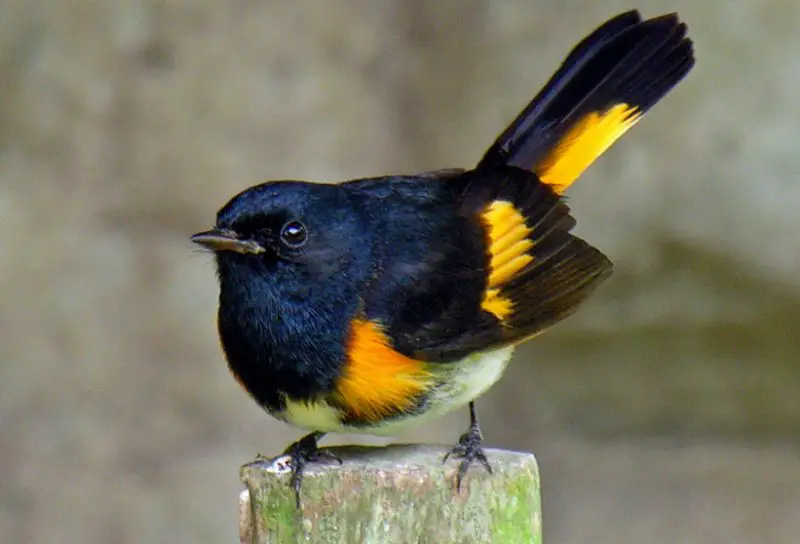
The American Redstart is a small warbler with striking black and orange plumage in males, while females and immature birds show yellow patches instead of orange. Its bold coloration and energetic behavior make it highly distinctive. Males often flash their bright tail and wing patches while foraging to startle insects into flight.
These birds feed mainly on insects, particularly flies, caterpillars, and beetles. Their feeding strategy is active and acrobatic, involving hovering and tail-fanning to capture prey midair. They are also known to eat berries, especially during migration or in late summer.
American Redstarts inhabit deciduous forests, woodlands, and shrubby areas throughout Massachusetts. They are migratory, arriving in the spring to breed and departing to Central America and the Caribbean for the winter. Their striking appearance and lively behavior make them favorites among birdwatchers.
Black-and-white Warbler

The Black-and-white Warbler is a small, striking bird with black-and-white streaked plumage and a thin, slightly curved bill. Unlike most warblers, it creeps along tree trunks and branches like a miniature nuthatch, searching bark for insects. This unusual behavior makes it a standout in the forest.
They primarily eat insects and spiders, foraging meticulously along tree bark and often flipping leaves to find hidden prey. Their song is a high-pitched “wee-see, wee-see,” which can help locate them in dense forest undergrowth.
Black-and-white Warblers prefer mature deciduous and mixed forests but can also be found in wooded suburban areas. They breed in Massachusetts during the spring and summer, then migrate to Central America and the Caribbean for the winter. Their unique foraging style and bold contrasting plumage make them easy to identify among warblers.
Yellow-rumped Warbler
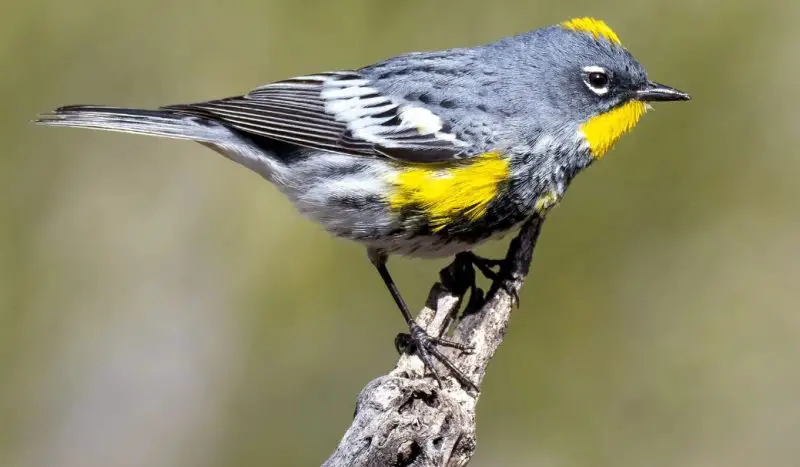
The Yellow-rumped Warbler is a medium-sized warbler with grayish-blue upperparts, streaked underparts, and bright yellow patches on the rump, sides, and crown. Its yellow rump is the most distinctive feature and allows it to be seen even at a distance. Both males and females show yellow accents, though males are generally more vibrant.
These warblers are versatile foragers, consuming insects, berries, and seeds depending on the season. They are one of the few warblers able to digest the waxy berries of bayberry and wax myrtle, which helps them survive northern winters. Their song is a musical trill, often heard from the tops of conifers and deciduous trees.
Yellow-rumped Warblers breed in coniferous and mixed forests, particularly in the northern parts of Massachusetts, and migrate south for winter, though some may overwinter in coastal areas. They are one of the most adaptable and widespread warblers in the state.
Northern Mockingbird
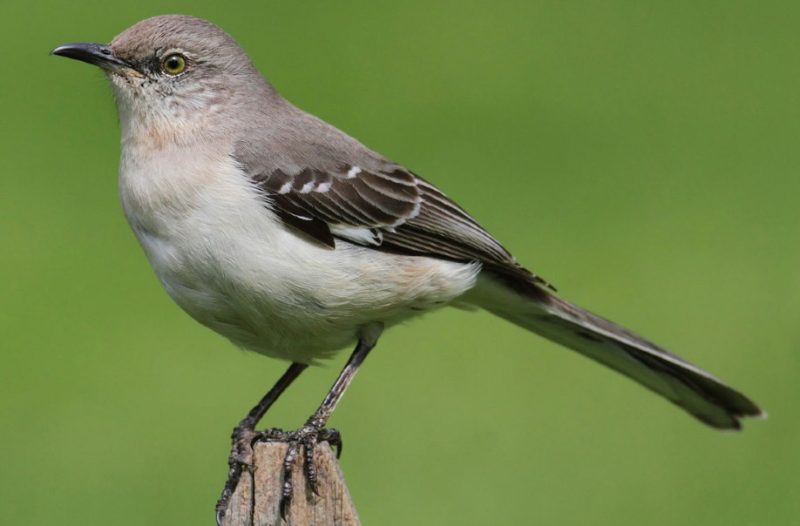
The Northern Mockingbird is a medium-sized songbird with gray plumage, white wing patches visible in flight, and a long tail. Both sexes look similar, though males may be slightly larger. They are renowned for their vocal abilities, mimicking other birds, frogs, and even mechanical sounds, often singing continuously day and night during the breeding season.
Northern Mockingbirds feed on insects, fruits, and berries, foraging on the ground and in shrubs. They are bold and territorial, often chasing away much larger birds and defending their nests aggressively. Their adaptability to human-dominated environments makes them common in residential areas.
These birds inhabit open fields, suburban yards, and forest edges throughout Massachusetts. They are year-round residents in the southern part of the state, while northern populations may move slightly south in winter. Their brilliant singing and mimicry make them a favorite among birdwatchers.
Belted Kingfisher

The Belted Kingfisher is a medium-sized bird with a stocky body, large head, and shaggy crest. Its plumage is slate-blue above with a white collar and underparts, marked by a distinctive blue breast band in males and an additional rusty band in females. The long, straight bill is ideal for catching fish, its primary diet.
Belted Kingfishers are skilled hunters, diving from perches or hovering briefly before plunging into water to capture fish, crustaceans, and aquatic insects. They are often seen perched on branches or poles near streams, rivers, or ponds, scanning for prey. Their rattling call is loud and unmistakable, signaling territory or alerting nearby birds.
In Massachusetts, Belted Kingfishers are found near freshwater bodies, including rivers, lakes, and reservoirs. They are year-round residents in some regions but may migrate south during harsh winters. Their presence is often a good indicator of healthy aquatic ecosystems.
Great Blue Heron
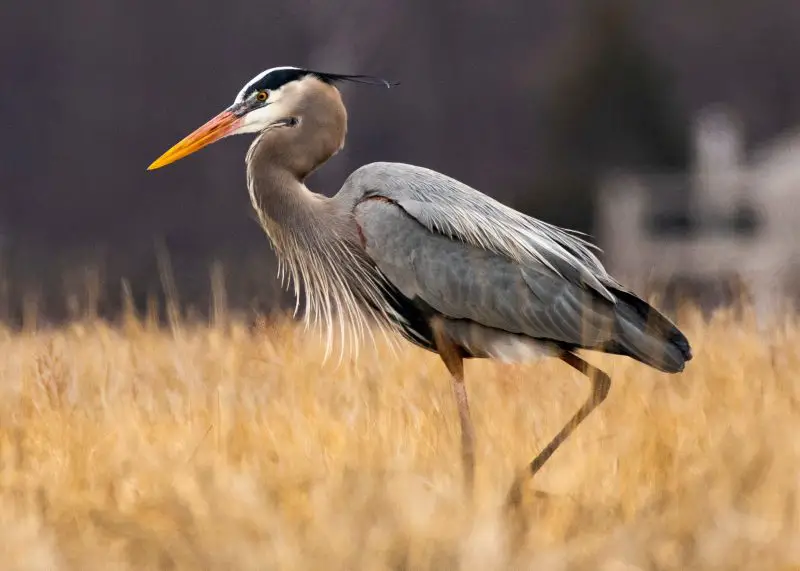
The Great Blue Heron is a tall, elegant wading bird with slate-gray plumage, long legs, and a slender neck that forms an S-curve when at rest. Its distinctive black plumes extend from above the eyes, and its massive wingspan, up to 6 feet, makes it a striking figure in flight. The long, pointed yellow bill is perfect for spearing fish and amphibians.
Great Blue Herons are patient hunters, standing still for long periods before striking quickly to catch fish, frogs, small mammals, or insects. They hunt in shallow water along the edges of ponds, rivers, and marshes, and are also known to feed in fields during low water periods. Their slow, deliberate flight is accompanied by steady wingbeats, often with their neck tucked into an S-shape.
In Massachusetts, Great Blue Herons breed in freshwater and coastal wetlands, forming colonies called heronries. They are present year-round in milder coastal areas but may move southward from northern regions in winter. Their size and presence make them one of the most iconic waterbirds in the state.
Canada Goose
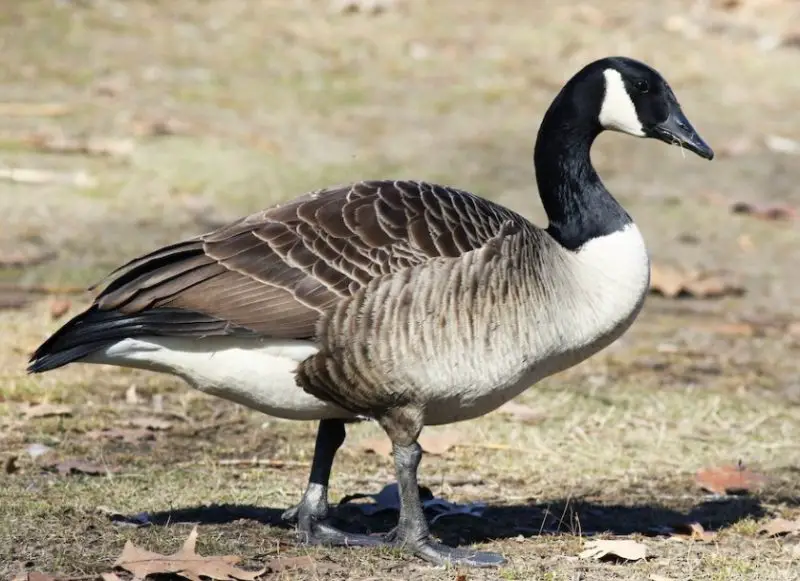
The Canada Goose is a large, long-necked waterfowl with a black head and neck, white cheek patches, and a brown body. Its wings are broad, and in flight, they form a strong V-formation during migration. Adults range from 30 to 43 inches in length, with wingspans reaching up to 6 feet.
Canada Geese are grazers, feeding mainly on grasses, aquatic plants, and grains. They are highly adaptable, foraging in wetlands, fields, and urban parks. Their vocalizations, a series of honking calls, are familiar sounds during migration and in breeding areas. These geese are also known for their strong pair bonds and protective behavior toward their goslings.
In Massachusetts, Canada Geese are common year-round, with large migratory flocks arriving in spring and fall. They breed near lakes, ponds, and rivers, and their adaptability to human-altered landscapes has allowed populations to thrive across the state.
Mallard Duck
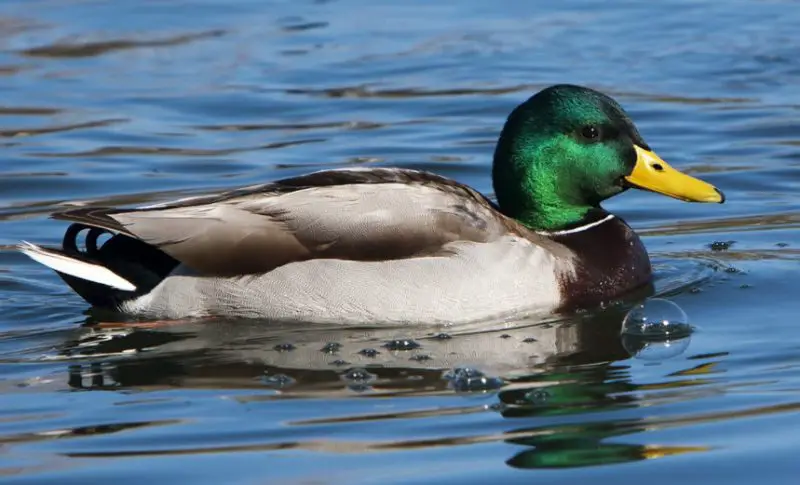
The Mallard Duck is a medium-sized dabbling duck, with males displaying a glossy green head, white neck ring, chestnut-brown chest, and grayish body. Females are mottled brown with orange bills, providing excellent camouflage. Both sexes have a characteristic blue speculum on the wings, bordered by white.
Mallards feed primarily on aquatic plants, seeds, and small invertebrates, dabbling at the water’s surface rather than diving. They are highly social, often seen in flocks, and males display courtship behaviors such as head-pumping and tail-raising to attract females. Their quacking calls are loud and recognizable.
Mallards are highly adaptable, nesting near freshwater ponds, marshes, and rivers. In Massachusetts, they are abundant year-round, though northern populations migrate south in winter. Their widespread presence and adaptability to human environments make them one of the most familiar waterfowl species in the state.
Wild Turkey
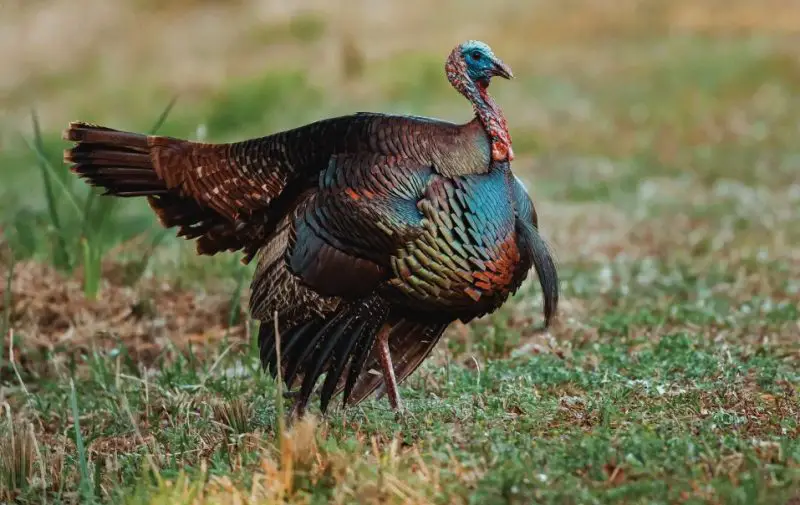
The Wild Turkey is a large, ground-dwelling bird with a dark, iridescent body, long legs, and a fan-shaped tail. Males, or toms, have a distinctive red wattle, blue head, and spurred legs, while females are smaller with duller coloring. Their large size, strong legs, and keen eyesight make them formidable in the wild.
Wild Turkeys are omnivorous, feeding on seeds, nuts, fruits, insects, and small reptiles. They forage in flocks, scratching the forest floor to uncover food, and roost in trees at night for safety. Males display elaborate courtship behaviors, including strutting, wing spreading, and tail fanning to attract mates.
In Massachusetts, Wild Turkeys inhabit forests, fields, and edges of suburban areas. They were successfully reintroduced in the state and now have thriving populations. Their adaptability and social behavior make them increasingly common across rural and semi-urban landscapes.
FAQs about Common Birds in Massachusetts
What are some of the most common birds found in Massachusetts?
Massachusetts hosts a wide variety of birds year-round, including American Robins, Northern Cardinals, Blue Jays, Black-capped Chickadees, Tufted Titmice, Mourning Doves, and many others. Seasonal migrants such as Warblers, Orioles, and Swallows also appear in spring and summer.
How can I identify a Northern Cardinal?
Northern Cardinals are bright red (males) with a black mask around the face, while females are warm brown with red tinges on the wings and tail. Both sexes have a distinctive crest on the head and a thick, cone-shaped bill, making them easy to spot in shrubs or backyard feeders.
What is the best time to observe migratory birds like Warblers in Massachusetts?
The best time to observe migratory birds is during spring (late April to early June) when they arrive to breed, and again in fall (August to October) during their southward migration. Early morning is often the most active time for sightings.
How do I distinguish between similar-looking crows and ravens?
American Crows are smaller with a fan-shaped tail, while Common Ravens are larger, have a wedge-shaped tail, and produce deeper, croaking calls. Observing flight pattern, size, and vocalizations helps in identification.
What do birds like the American Redstart and Yellow Warbler eat?
These small songbirds primarily eat insects, including caterpillars, beetles, and spiders. During migration or winter, they may also consume berries and fruits to supplement their diet.
Where can I find waterfowl like Mallards and Canada Geese in Massachusetts?
Waterfowl are commonly found in freshwater ponds, lakes, rivers, wetlands, and coastal marshes. Mallards and Canada Geese are highly adaptable and are often seen in parks and urban ponds as well.
Are some of these birds year-round residents or seasonal migrants?
Some species, like Black-capped Chickadees, Tufted Titmice, Northern Cardinals, and American Crows, are year-round residents. Others, including warblers, orioles, swallows, and Scarlet Tanagers, are migratory, appearing only in spring and summer.
How can I attract backyard birds like Baltimore Orioles or Cedar Waxwings?
Providing native fruiting plants, nectar feeders, and insect-rich habitats helps attract these birds. Orioles enjoy orange slices and sugar water, while Waxwings feed on berries. Ensuring water sources and shelter also increases the likelihood of visits.
Do birds like Wild Turkeys and Great Blue Herons have specific habitats?
Yes, Wild Turkeys prefer forests, field edges, and suburban landscapes with open areas for foraging. Great Blue Herons are associated with wetlands, ponds, rivers, and marshes, where they hunt for fish, amphibians, and small aquatic animals.
Can I observe birds year-round in Massachusetts?
Yes, with a mix of year-round residents and migratory species, Massachusetts offers birdwatching opportunities throughout the year. Winter highlights include Dark-eyed Juncos, Northern Cardinals, and some waterfowl, while spring and summer showcase warblers, orioles, and swallows.

